Rockwell Automation Accelerates Connected Enterprise Software at 2014 RSTechED
LNS Research's Mark Davidson shares his thoughts and experiences from RSTechED 2014.
With more than 50,000 attendees in Las Vegas from November 27 – December 1, 2023, and more than 300,000 watching online, AWS re: Invent is the biggest cloud computing conference in the world. AWS re:Invent is a learning conference hosted by AWS. The event is so big that it is more accurate to describe it as a collection of co-located events, including multiple keynote sessions, trainings, certifications, over 2,000 technical sessions, and an expo featuring AWS and partners.
Launching 212 significant new features, six new programs, 76 new services, and 28 customer/partner announcements, AWS is continuing to invest in its leadership position in the cloud.
AWS re:Invent is more focused on generic cloud technologies than applications for industrial operations. Still, many of these technologies have significant value for manufacturers and software vendors that create industrial applications. This write-up focuses on areas where we see benefits for the industrial domain.
As with all the recent software events, Generative AI was front and center in many sessions, including keynotes from CEO Adam Selipsky, Vice President Dr. Swami Sivasubramanian, and CTO Dr. Werner Vogels.
More than shiny objects: This is not the first time we have seen a new technology getting a lot of attention, and we all have burns from following shiny objects too closely. But unlike the recent rise and fall of blockchain technology, Generative AI is linked to an ever-growing list of real use cases. LNS Research has recently documented common use cases for Generative AI in manufacturing. This technology still has a lot of opportunities; AWS is stating that Generative AI is far from reaching its peak on the maturity curve and is likely at the beginning of the typical S curve for new technologies.
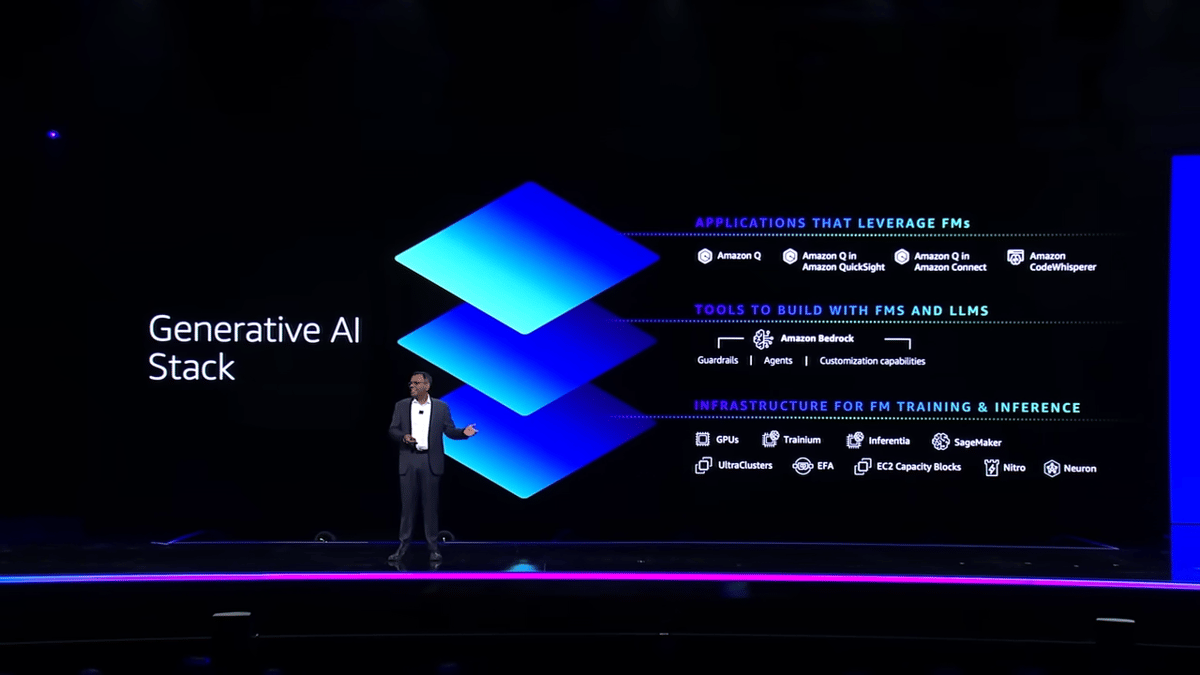
Amazon Q: AWS is implementing Generative AI across its product portfolio and announced that CodeWhisperer is joined by Amazon Q as a generic tool to guide users through the jungle of AWS services. Q should not be confused with the elusive OpenAI Q* you may have heard about. While they share the letter Q, Amazon's offering has borrowed its name from the head of the fictional research and development division in the James Bond stories.
No foundational model to rule them all: AWS' offering is differentiated from the competition by allowing Bedrock users to select from a wide range of foundational models, including Anthropic Claude, AI21Labs, and Amazon Titan (but no OpenAI). AWS argues that there will not be one foundational model to rule them all. Different models will offer varying capabilities and costs to fit different needs. While large models are currently getting the most attention, AWS demonstrated how smaller focused models can be more predictable, faster, and cheaper. Some users may be confused by all the options that must be selected, and AWS is offering Generative AI to help guide the users through the process of selecting the foundational model. The market for foundational models is not settled, and AWS' approach encourages competition between the vendors without making a single bet.
Security and Safety: AWS stated several times that their approach was safer than competitors' solutions, but the messaging about the security features mirrors that of other players. Safety and security are significant issues in Generative AI that need to mature; suppliers are trying to patch issues with deny (black) lists instead of solving the problems at the root with allow (white) lists. We repeatedly see that attempts to lock down Generative AI models are being hacked: Trying to list everything that is illegal feels like a game of Whack-A-Mole. So far, the most viable approach is using smaller models with content targeted at a specific and limited subject matter.
Accessibility: Like OpenAI's GPTs, AWS is simplifying the creation of applications using generative AI with PartyRock. PartyRock allows users to build applications without any code, purely through prompts. It is so simple to use that no machine-learning experience is needed. Unlike GPTs, users can build simple user experiences by dragging and dropping UI widgets. Widgets can include user input, static text, text generation, image generation, and chatbots; they can be linked together, creating an immersive experience that can guide a user through the application. On the downside, there is no way to load additional knowledge into the application beyond the text provided when configuring the widgets. This technology shows much promise but needs additional features before it is ready for industrial use.
Investments ahead: AWS is still working on the plumbing of Generative AI and applications. We expect deep content to soon be available for industrial operations users in AWS and partner products. AWS has the benefits of a comprehensive cloud offering and a healthy partner network where AI can quickly add value.
Industrial Value: Industrial-Operations is a complex space. LNS Research sees significant benefits in simplifying access to domain knowledge and adoption of technology by using Generative AI. We recommend that all manufacturers educate themselves about the opportunities and limitations of these technologies so that they can be evaluated as part of the broader operational architecture. However, blind trust in Generative AI can have unintended consequences and lead to sub-optimal decisions.
Serverless computing offers cost-effective and flexible scalability without the need to manage servers. It is particularly beneficial for dynamic workloads that require a varying amount of infrastructure.
Stateful Serverless: AWS re:Invent 2022 demonstrated significant investments in Lambda functions last year. Lambda functions are serverless, stateless code with a short life expectancy. In 2023, AWS highlighted investments in a different type of serverless functionality by extending their serverless database offering, which is stateful and has a longer life expectancy. AWS's first serverless database was DynamoDB on demand, which was introduced at AWS re:Invent in 2018, so the serverless database is not a new invention. At this event, AWS announced the Amazon Aurora Limitless Database, which has the power to scale to petabytes with millions of writes per second. This announcement dramatically increases the flexibility and scalability of the industry-leading MySQL and PostgreSQL-compatible databases, showing that "traditional" databases still have a lot of power.
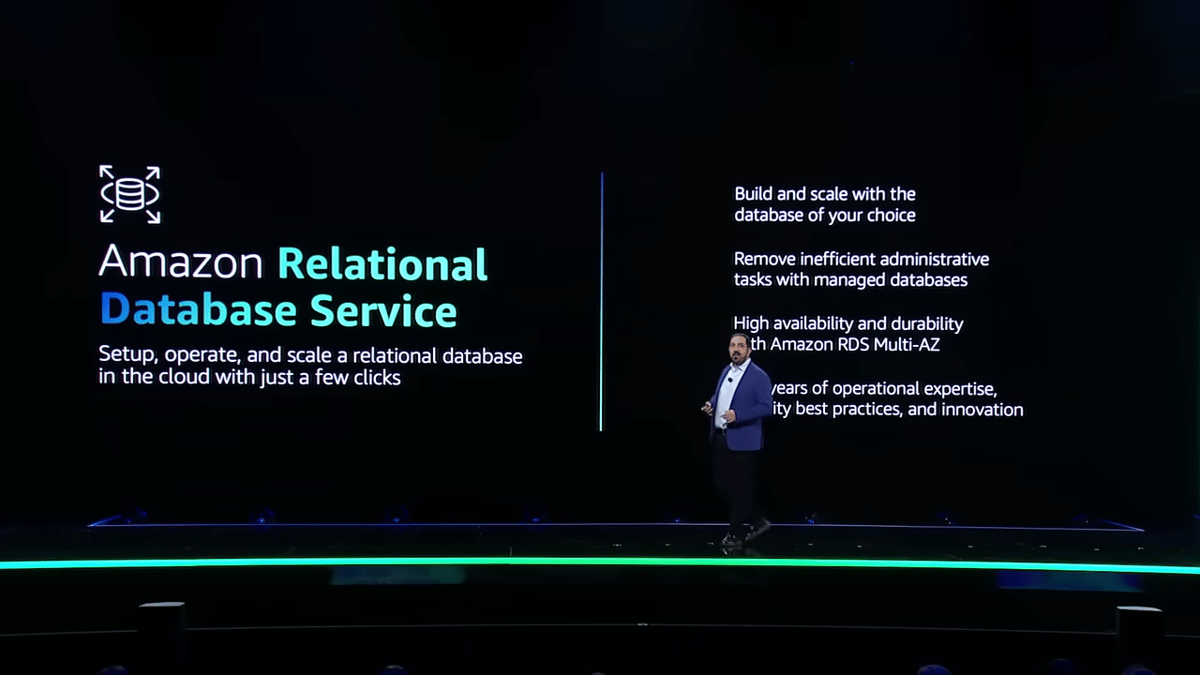
Scalability and Performance: Additional serverless applications were announced for Amazon ElastiCache for large high-performance applications and Amazon Redshift for large data warehouses.
Industrial Value: While most industrial operations applications have a relatively static workload, reducing the need for serverless flexibility, these new offerings have value for manufacturers with large analytics loads and companies that scale out their solutions across many sites. Keep in mind that you must choose your implementation wisely; serverless is not for everyone.
Anyone who has tried integrating data and analytics across multiple data sources has seen the challenges of the Extract, Transform, and Load (ETL) pattern. Creating and maintaining ETL processes is complex and time-consuming. Running these processes is resource-intensive and can cause delays and data quality and consistency issues.
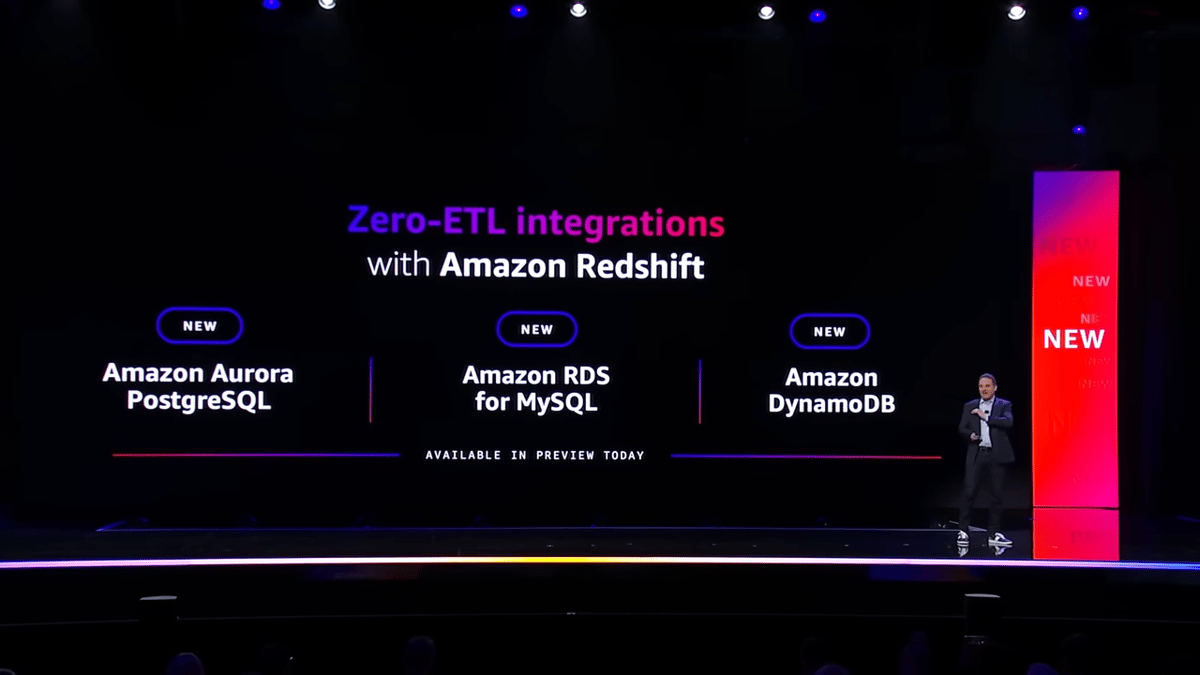
New Integrations: Amazon announced new integrations that enable customers to connect and analyze data without building complex ETL pipelines. These new capabilities are offered for Amazon Aurora PostgreSQL, Amazon DynamoDB, and Amazon Relational Database Service (Amazon RDS) for MySQL. They enable integration with Amazon Redshift and make connecting and analyzing transactional data from multiple relational and non-relational databases easier.
Industrial Value: Industrial data is dynamic data, and its value is the highest while it is fresh. Issues must be analyzed and resolved in near real-time, meaning that the long delays often resulting from ETL processes can be a hindrance. Manufacturers can now build a data warehouse using Amazon Redshift while reducing the need to move the data before it can be used.
Amazon has consistently invested in partnerships and domain knowledge for a long time. While AWS, at its core, has a horizontal set of capabilities, they have also built ecosystems for industry verticals.
The Manufacturing Team: We met with the AWS manufacturing team throughout the week. The team has deep domain knowledge and is building industrial services like AWS SiteWise and AWS SupplyChain and frameworks like Industrial Data Fabric, including reference architectures and integrated partner solutions.
Product Partners: Two product partners that stood out were Siemens and HighByte.
The Siemens relationship is building momentum. We met with Siemens VP Satya Musti and attended a presentation on AWS IoT SiteWise Edge by Nicolas Pouyez and Torben Poertner. They announced that AWS IoT SiteWise Edge is now available on the Siemens Industrial Edge Marketplace – this is a significant milestone on the long road of IT/OT convergence. Siemens Digital Industries Software was awarded AWS Industry Partner of the Year for Manufacturing and Industrial.
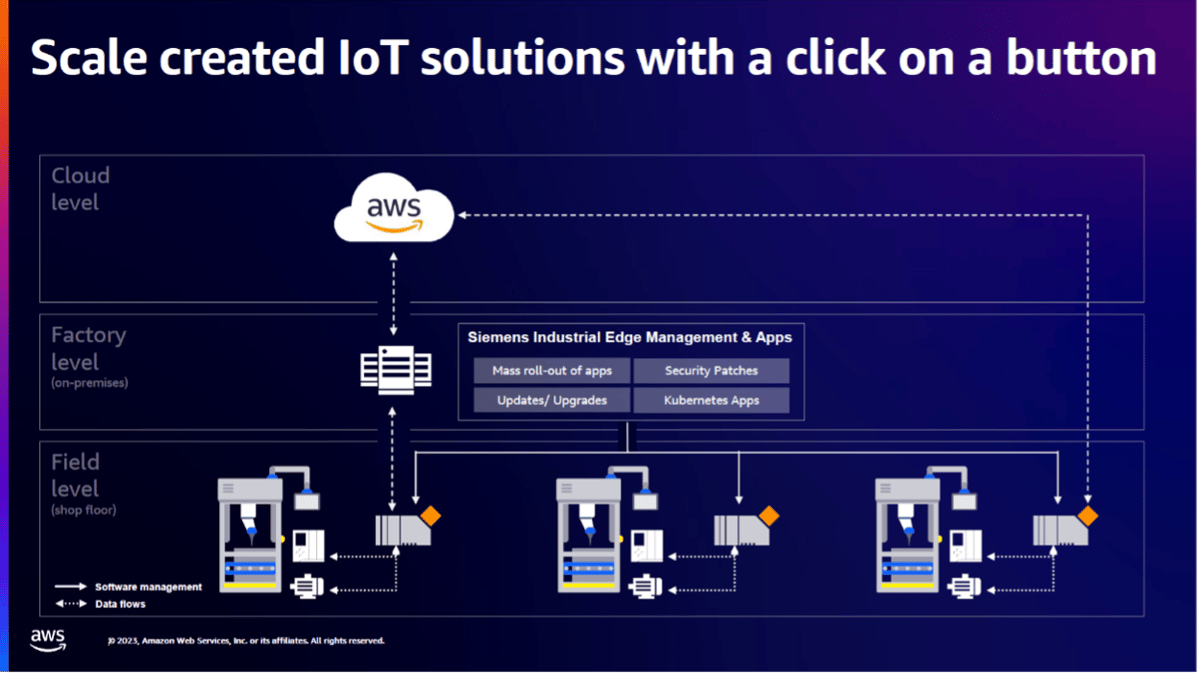
HighByte is continuing to develop its AWS partnership. HighByte is a central building block of AWS' Industrial Data Fabric. We met with CPO John Harrington, CCO Torey Penrod-Cambra, and CTO Aron Semle. HighByte is focused on making industrial data useful and provides the connectivity layer between the plant floor and the cloud. HighByte Intelligence Hub enables you to standardize, organize, and merge your industrial data into a single equipment model.
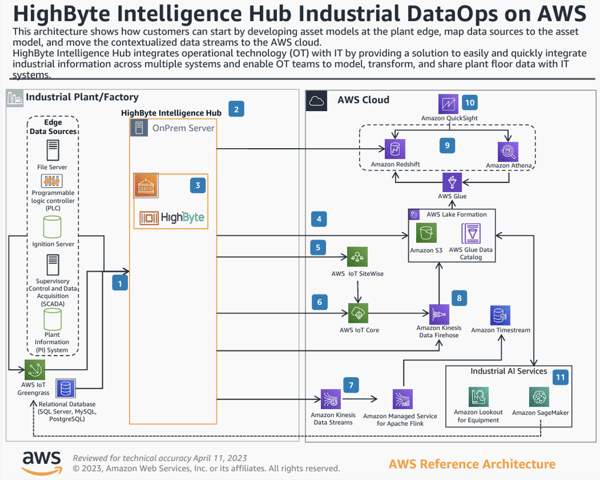
Services Partner: Cognizant has deep IT and OT experience and was awarded AWS Industry Partner of the Year for Healthcare and Life Sciences. We met with Sharath Prasad and Ratna Sarma, who shared their OnePlant framework for integrating manufacturing operations.
Industrial Value: It is complex to build an architecture for industrial operations. The data sources and use cases are diverse, and the landscape and requirements are ever-changing. It can be an overwhelming task to understand and build an architecture that will last for decades. Amazon's partner ecosystem and reference architecture ease the burden and allow manufacturers to engage with professional companies that have experience in the field.
A collaborating supply chain will beat a competing supply chain any day. AWS launched the Amazon Supply Chain in 2022. The initial release focused on retail distribution. AWS announced the addition of a Bill of Materials capability for the Supply Chain software; this allows the software to expand deeper into the supplier network and add new capabilities for manufacturing.
Secure Collaboration: AWS Clean Rooms enable collaboration with partners without sharing raw data. The data can be processed and analyzed before it is shared with tools like Amazon QuickSight (BI), Amazon SageMaker (AI), and Amazon Redshift (DW).
Industrial Value: While these announcements are still very fresh, we see opportunities for using these tools for better supply chain collaboration where multiple partners can securely share information along the value chain. The direction that AWS is taking is exciting, and we will be watching the continued investment in this space.
Recently, we have seen an increase in CTO keynotes that are less technical in nature. We view this as a good sign; it bridges the gap between the business and the technology while emphasizing how the technology is used and the value it creates.
CTO Dr. Werner Vogels talked about the lost art of architecting for cost – this may be a backlash for the huge AWS bills many customers have seen. He took a holistic view covering how to design, measure, and optimize software; it felt like a computer science economics class for studying constrained cloud resources.
The Frugal Architect: Dr. Vogels has created an online booklet with seven simple laws for building cost-aware, sustainable, and modern architectures. While most of the laws come across as common sense, it is noteworthy that the leading Hyperscaler is focused on helping customers use their infrastructure more efficiently. Law II is particularly interesting; it talks about aligning cost to business value; we have seen several failed software players that offer unlimited options without understanding the cost. An example showed how PBS reduced its streaming cost by 80% after optimizing its architecture.
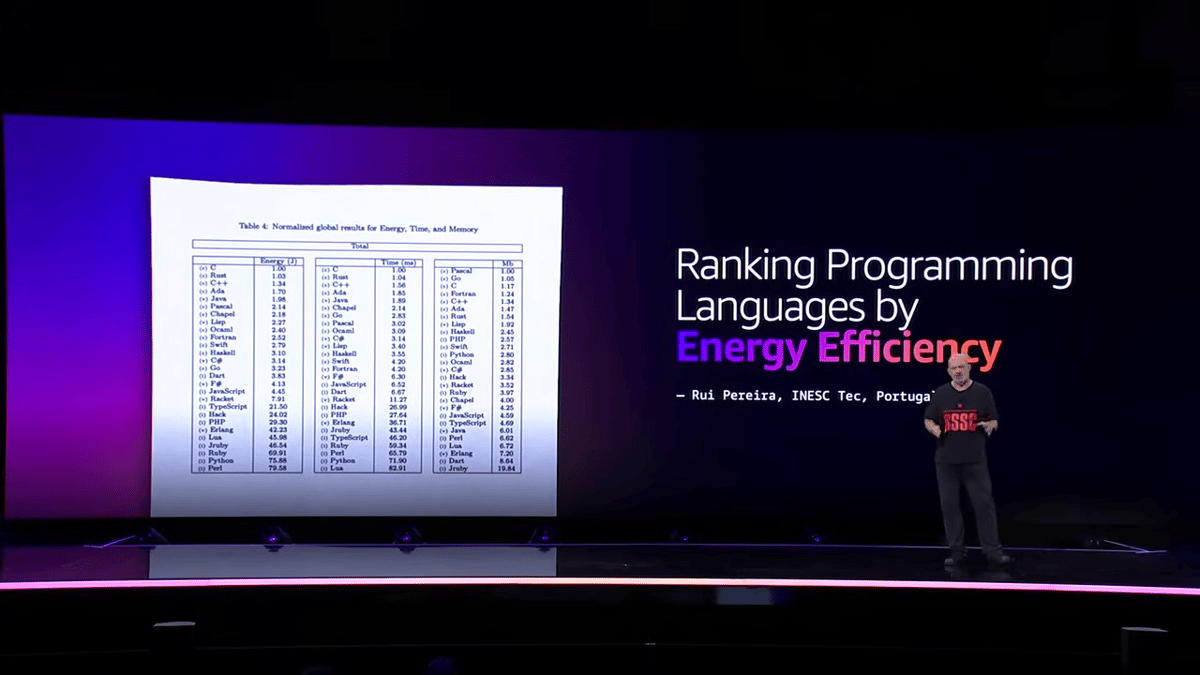
Sustainability: Many people may not realize it, but IT infrastructure consumes 3-4% of the world's electricity. While this number may seem small, IT adoption is increasing, and it is energy that is turned into heat. Cost is a close proxy of sustainability, so reducing energy usage will also reduce costs. Not all IT solutions are made equal: Dr. Vogels said that you can architect more energy-efficient solutions and choose programming languages like Rust, which is 50 times more energy-efficient than Python.
Using Amazon Q: AWS admits that it is too much for a single person to be an expert in the entire AWS cloud space. Amazon Q, the Generative AI assistant, can be the expert who sits next to you and helps you build sustainable architecture and well-designed applications.
Industrial Value: Manufacturing operations are cost-sensitive; manufacturers are constantly trying to reduce operating costs and maximize cash flow from operations. Most manufacturers have a sustainability focus – they know they must be sustainable if they want to survive. Building a frugal architecture can achieve both of these goals.
AWS is relentlessly investing in building managed cloud and edge infrastructure, platforms, and applications. It is an enormous undertaking, and it is clear that the vast majority of industrial operations architectures will include one or more cloud Hyperscalers.
Moreover, AWS is wisely partnering with software, hardware, and services suppliers when creating the blueprints for the solutions. This investment must continue as the industrial space is too extensive and diverse to have one solution to fulfill all the needs.
The progress in Generative AI is astounding, but we must apply this new technology with our eyes wide open. It is clear that an over-confident approach will lead to failure in the accuracy of data and in the safety of how it operates.
While multiple cloud providers can cooperate, selecting the cloud providers for industrial operations is a strategic decision. If you choose wisely, many other pieces will fall in place. Each cloud Hyperscaler has its own strengths and weaknesses; Microsoft Azure, Oracle Cloud Infrastructure, and Google Cloud Platform all benefit in certain market areas and should be on most manufacturers' shortlists.
Industrial-operations software is a complex domain, and it is too early to declare victory. There are still many paths to failure related to connectivity, complexity, cost, sustainability, analytics, and integration. We advise manufacturers to stay alert and measure the value of every new innovation against their business objectives; one of the biggest failure modes is to trust every new shiny object that appears.
As a member-level partner of LNS Research, you will receive our expert and proven Advisory Services. These exclusive benefits give your team:
Let us help you with key decisions based on our solid research methodology and vast industrial experience.
BOOK A STRATEGY CALLSiemens Acquires Camstar: Better Realizing Innovation for 3 Vertical Industries
The Definitive Guide to Manufacturing Acronyms
Five Ways Industrial AI is Shaking Up Manufacturing (and Who’s Doing It)
Top 6 Challenges in Electronics Manufacturing
What Is Industrial DataOps & Why Does Every Manufacturer Need It?
LNS Research's Mark Davidson shares his thoughts and experiences from RSTechED 2014.
Research review of the 2019 Rockwell Automation Fair in Chicago, IL.
Software-Defined Automation boosts flexibility, security, and efficiency by decoupling control logic from hardware in industrial systems
The Industrial Transformation and Operational Excellence Blog is an informal environment for our analysts to share thoughts and insights on a range of technology and business topics.